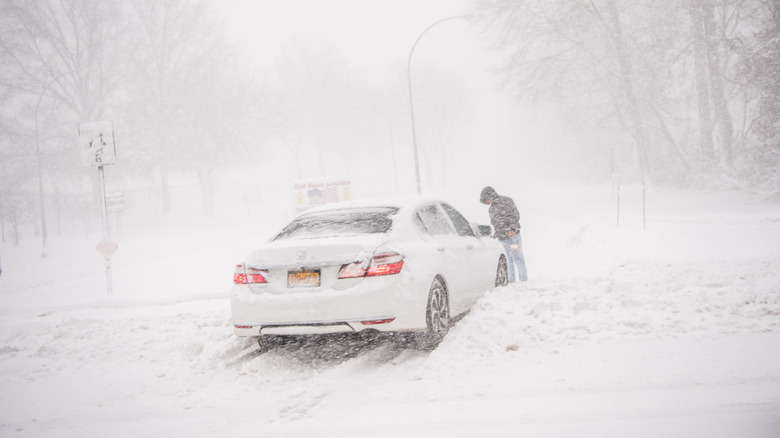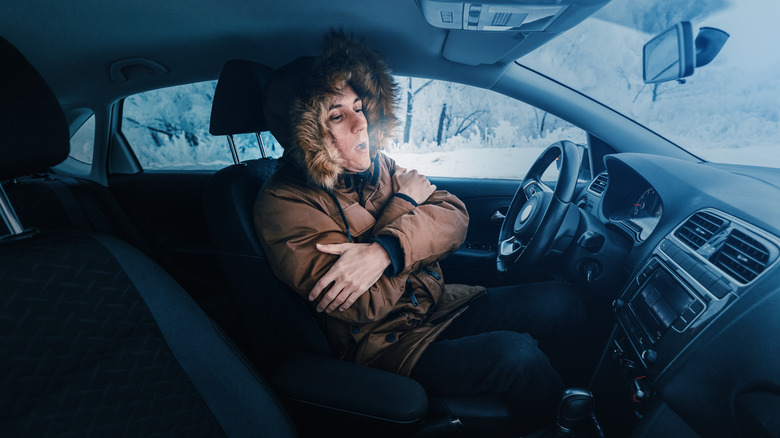How To Survive If You're Stuck In Your Car During A Snow Storm
It may seem nonsensical to say that climate change would lead to more widespread and stronger snowstorms across the northern hemisphere. For many years, "global warming" was the preferred term for climate change in both the scientific community and mainstream media, and as a result many readers have quite understandably taken that to mean that the change in temperatures that scientists predicted would mean clearer skies and more sun.
But in 2022, Scientific American published an article explaining that manmade climate change looks set to unleash more snow across America than ever before, as warmer winter air is capable of holding more moisture, and therefore of producing more snow, blizzards, and snowstorms. And the following year the scientist's concerns certainly played out. While 2023 was widely reported to have been the hottest year on record worldwide by a worryingly large margin, weather reports from across North America saw widespread snowstorm alerts, particularly on the East Coast.
Compared to lightning storms or flash floods, snowstorms may seem comparatively benign. But heavy snowfall can be dangerous, especially for drivers, who can find themselves unable to control their vehicle or trapped in a remote location with no chance of driving their way to safety. Here is what to do if you find yourself trapped in an immobile vehicle during a snowstorm.
Stay in place
Let's imagine you've found yourself in a situation that every driver dreads: you've set out in your vehicle on a cold day with light snowfall, tiny flakes that are so small it looks impossible they could stick to the ground. You drive a couple of miles and conditions remain the same, so you decide to push on down a remote highway that stretches on for hundreds of miles before you reach your destination. But then a snowstorm hits, and before long you find your wheels spinning and your vehicle comes to a complete stop. What do you do?
The National Weather Service warns that leaving your vehicle to look for help in the middle of a snowstorm is incredibly dangerous. Even if you are wearing the correct gear to keep yourself warm outdoors, with heavy snowfall it is easy to lose your bearings and you can become disorientated, meaning that you may lose sight of your vehicle and find yourself stranded in the snow. The best thing to do is to stay in your vehicle and wait for the storm to pass, and to keep the vehicle as warm as possible. Their advice is to run your engine for 10 minutes every hour to warm the vehicle while opening the window occasionally to ensure to dissipate any buildup of carbon monoxide. You should check the exhaust pipe occasionally and clean out any accumulation of snow that may block it up.
Be visible, and go slow
The United States government website Ready suggests assembling a kit to be used in emergencies that you can keep inside your vehicle, while the National Weather Service recommends always taking a fully charged cellphone with you when driving. If you have adequate reception, you can call 911 for help, making sure to describe your location as precisely as possible so you can be found. If not, it is in any case worth making your vehicle as visible as possible to any rescue teams that may be passing your way.
The National Weather Service states that if you have any colorful clothing — preferably red — or other bright objects, attach them to the outside of your vehicle. Turning on your dome light when running your engine can help attract attention, as can raising the hood of your vehicle to indicate that you need help.
If you find that your car is eventually able to move, keeping things slow and steady is key. Though conditions may seem less dramatic than when you were snowed in, the melting ice could make controlling your vehicle difficult. Only set off once your vehicle is entirely free of ice, and stay at a low speed.


